David Coulthard, the 13-time grand prix winner who turned 50 earlier this year, was promoted into Formula 1 in the wake of Ayrton Senna’s death at Imola in 1994.
Having served as Williams’ test driver for the previous year-and-a-bit he was an obvious choice. To imply he owed his career solely to the Brazilian’s tragic death would do Coulthard a grave disservice, for one doesn’t win an average of a grand prix per season through pure fortune.Having come up through karting, DC won both 1989 British Formula Ford titles before moving to Vauxhall Lotus and F3, placing fourth and second in 1990 and 1991 respectively. During the latter season he won both F3 blue riband events, namely Zandvoort’s Marlboro Masters and the Macau Grand Prix with Paul Stewart Racing.
His first taste of F1 had, though, come in November 1990 with the V12-powered McLaren-Honda MP4/5B test car – his prize for winning the inaugural (1989) BRDC McLaren Autosport Award.
“It was a wet day at Silverstone,” he recalls. “But it was [still] pretty impressive to feel all that power. It was incredibly smooth. From my point of view, it was impressive to see how well engineered it was, the acceleration, the gearbox. The lower formula cars were pretty raw.”

“It was a great opportunity because being a test driver in those days meant testing,” DC smiles. “I remember one year we tested until the 23rd of December, then I was testing again on 2nd of January, we really were out all the time.
“The majority of my career, even when I was [F1] racing, it would be: get home Sunday night [after a grand prix], Monday fly to the next test track, test Tuesday, Wednesday, Thursday, then fly to a promotion somewhere for a cigarette company. I’d get the weekend and Monday, Tuesday, Wednesday to prepare for the next grand prix…”
Advert | Become a RaceFans supporter and
For 1993 DC’s primary test project was the active suspension FW15 in its various evolutions and in manual and constantly variable transmission guises, plus testing the passive FW16 ahead of 1994. He recalls that the active suspension car felt “like a magic carpet ride. It really did smooth out the circuit because it was targeting ride height and didn’t have the pitch and the roll and everything you feel in a passive car.”
Active suspension was banned at the end of 1993. “With passive it felt like you were just being shaken to bits,” he recalls.
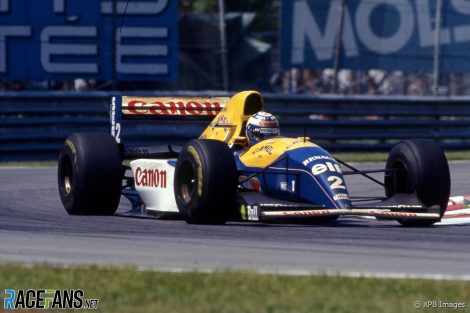
On other cars, active suspension was blamed for several major crashes. But while Williams encountered system failures, DC recalls the “failsafe always put the car on its bump rubbers – there was never a situation where it threw you off the track.”
As covered in a recent feature on innovation in Formula 1, the FIA banned continuously variable transmission while Williams was working on such a system. “It was a lot of fun working on the development,” its chief tester recalls.
Coulthard is evidently disappointed the system never made it to a race. “I remember the final flurry of it, because it was already banned before we’d actually finished the development,” he recalls.
“Once the FIA got on to the fact that Williams were working with the Van Doorne company to develop CVT, we did hot laps at Silverstone on the [club circuit], so it wasn’t on the full grand prix track.
“You had to get used to the fact that the engine would sit at its optimal power delivery.” He mimics the flat buzzing of an engine compared to the more familiar sound of revs rising and falling. “ So when you lifted off at the end of the straights the belt effectively moved down the two cones. That was slightly disconcerting, although it drove absolutely fine.
Advert | Become a RaceFans supporter and
There were no direct lap time comparisons, but DC reckons it would have been quicker because, “There was no gearshift, so no time loss. That was several years before we went to seamless shifts that saved you quite a bit of time, plus you would have had optimal power and constantly varying ratios. It probably would have been a good half second plus quicker than a standard car.”

“Renault were pretty adventurous with their [hydraulic] valves and developing rpm, which was good for giving us performance. Reasonably reliable – obviously, failures along the way, but nowhere near the amount of failures I had (later) when at McLaren-Mercedes, blowing engines nearly every day [during testing].”
Following a disagreement with Frank Williams at the end of 1994 – DC was basically on a test driver wage – he signed with McLaren for 1996, thus turning his second Williams year into an interim season with the FW17, effectively an evolution of what went before, albeit with Newey-style aerodynamic refinements to the front and rear wings, including aerodynamically shaped wishbones.
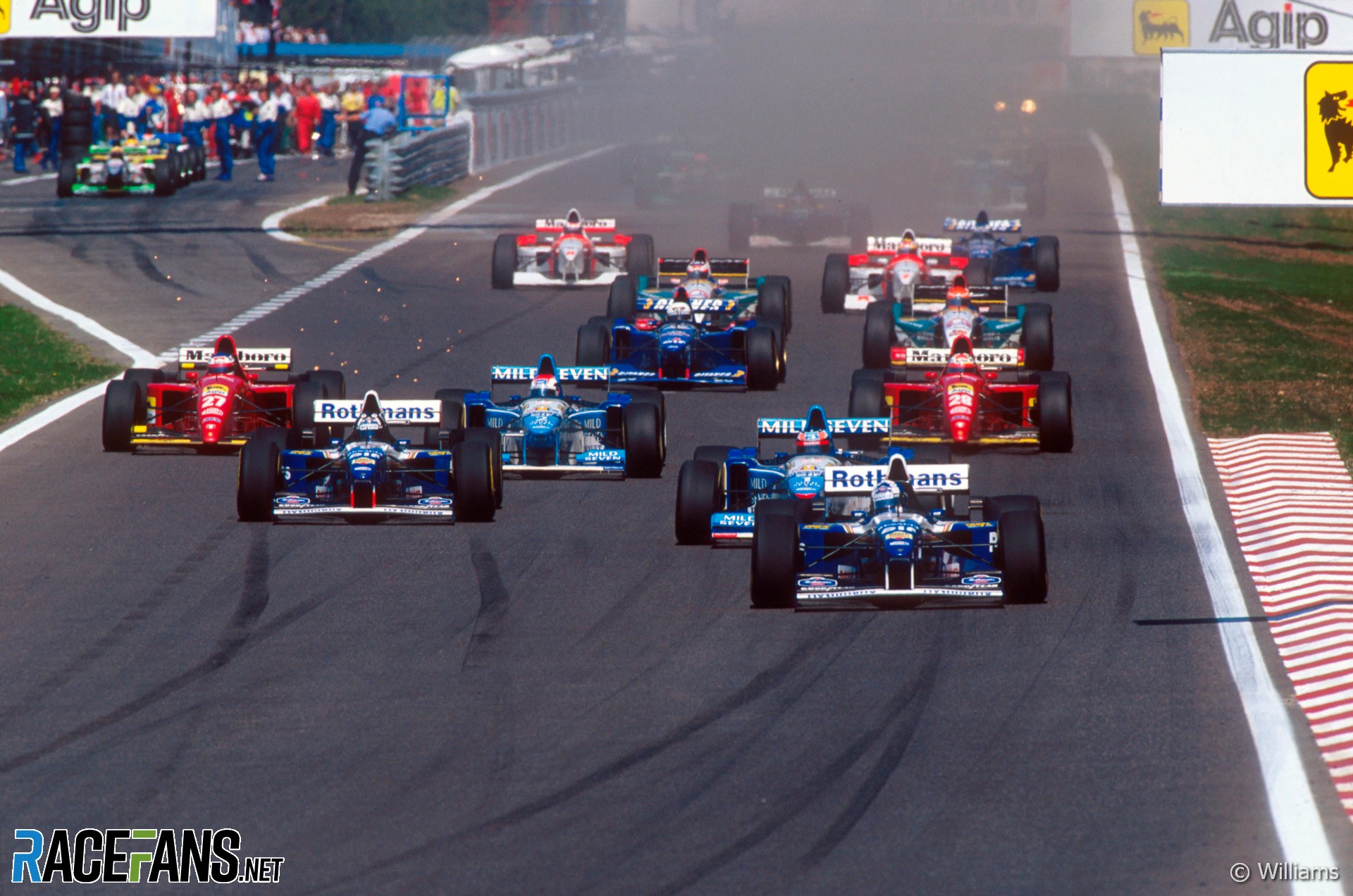
The FW17 was also the car that delivered his first grand prix win, at Estoril, with Michael Schumacher chasing him hard: “My first victory, so pole position, fastest lap, three-stop race which I remember being quite a challenge because you just got no time to get into cruise mode. I had to push every single lap because Michael was pushing me quite hard early on.
In his final race for Williams, at Adelaide, Coulthard thumped the pit lane barrier while coming in to pit from the lead. Technical glitch or driver error?
“I came in and did the downshift, then got an overdrive on the blips, so it gave me a push. By the time I semi-reacted I’d run out of space, so it looked like a straightforward driver fuck-up…”
After that Coulthard joined a McLaren team in rebuilding mode, having split with Honda, Ford and Peugeot in quick succession before signing with Mercedes from 1996. The team also switched title sponsorship from Marlboro to West a year later – hence DC’s first year with the Woking team was in traditional red/white livery; Silver Arrows war paint thereafter. Whatever, it was a shock to the system.
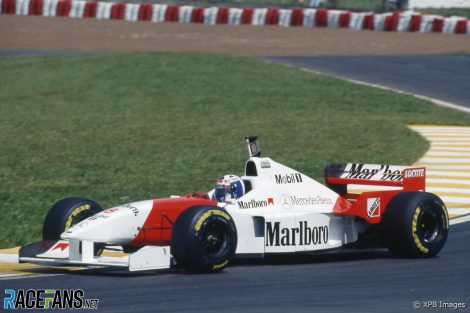
“When I tested it at the end of [1995], I was a bit nervous as to how scary it would be to drive. In actual fact, it was easier to drive than the ’95 Williams, and that was the first time I found out that fast cars are more difficult to drive than slow cars that don’t have downforce, and therefore they’re just not as peaky.
“There’s a perception that the Haas must be a bloody nightmare because it’s [currently] the slowest car, and that’s also why some drivers in let’s say, not very good cars, shine, but when they get into a top car they struggle because they can’t handle the peakiness.”
But the team was eager to make progress, as was its engine supplier. Coulthard recalls Mercedes engine director Mario Illien was “very brave, he would push the boundaries.
“I think we were getting through like 100-odd engines a year, just for testing, practice, qualifying and the races.”

A follow-up win for Coulthard in Monza helped him take third in the championship behind the Williams pair, following Schumacher’s disqualification. This was despite seven retirements, mainly due to engine failures.
The MP4-12 was the infamous ‘brake-steer’ car, featuring an additional pedal to control braking on one side of the car, which McLaren termed an ‘asymmetric braking system’. This was banned during the following season, but the driver reckons the system wasn’t the game-changer it was perceived to be.
“It helped rotate the car during understeer at high speed,” he says. “Yes, it gave performance, but it wasn’t the dominant reason. The ban took away some performance, but it wasn’t something that saw us suddenly drop off.”
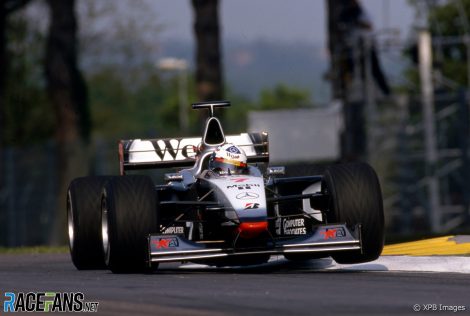
Generally, though, Coulthard struggled with the car: “It had understeer, so it was difficult to get the car rotated and getting the understeer out made the rear nervous. Mika was more comfortable with that particular situation – narrow car, grooves tyres – than I was initially.” Still, it delivered a win at Imola plus eight lower podiums, making for third in the championship.
During Coulthard’s tenure at McLaren the FIA moved to introduce stricter limits on how teams could operate their cars directly from the pit wall or even override the commands of the driver. As he relates, this led to a hair-raising moment when the team once set his car up to stay at full throttle for a particular corner – the high-speed left-right flick at the Nurburgring which follows the Dunlop hairpin – even if he lifted.
“If you lifted momentarily the Mercedes engine for whatever reason, I think it was the butterfly or slides, it just had a hesitation when it came back on power at high RPM, high speed,” Coulthard explains. “It was a sort of chicken-and-egg – if you didn’t lift, you were fine, but if you lifted you then were safe in the corner but then you lost time when you get back on power.”
McLaren’s solution for this corner was to programme the engine to keep the throttle wide open even if Coulthard lifted. “We programmed [it to] just stay flat then if you panicked, you would have to ride the brake.”
This was manageable for a low-fuel, sticky-tyred qualifying run, less so the next day when the car was brimmed with fuel for the race. “It was fine for quail but then they forgot to reset it going to the grid,” a wide-eyed Coulthard related. “On the formation lap the fucking thing took off! I had to get on the brakes and quickly reprogram [it] on the grid.”
With F1’s technical regulations effectively stable each car through to the end of Coulthard’s McLaren tenure was a Mercedes-powered evolution of the previous edition. The 1999 MP4-14 brought two wins and fourth place overall; the 2000 car three wins and third place and 2001’s MP4-16 provided a remarkably consistent run comprising two wins, eight further podiums and points scored in all races bar three events he retired from. But this proved insufficient for Coulthard and Hakkinen to resist the emerging dominance of Schumacher and Ferrari.
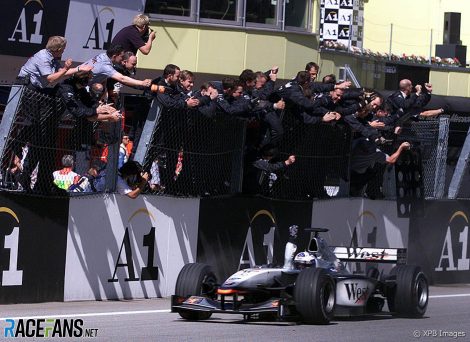
DC recalls that during his farewell gig at the 2004 Stars and Cars spectacular at Mercedes HQ in Stuttgart he was presented with a West-liveried bicycle – “Which was very nice of them” – with team executive Martin Whitmarsh then remarking, “Get on yer bike…”
“I’ll take Adrian (Newey) with me,’ vowed Coulthard, then. on his way to join the nascent Red Bull Racing squad, where he saw out the remaining four years of his F1 career. Newey signed with the squad within a year, but it took time for the design genius to slide his feet under the desk in Milton Keynes, re-arrange the technical department to his exacting standards and deliver his first Red Bull car.
The energy drinks-owned squad struggled during its maiden season. The RB1 was basically a re-liveried Jaguar powered by customer Cosworth V10s. Coulthard, fresh from one of F1’s most professional teams, was unimpressed with what he saw internally. Indeed, after day one of a scheduled two-day maiden test at Jerez he jetted off to meet with team owner Dietrich Mateschitz in Austria for serious talks.

That maybe have been the case in terms of his pure enjoyment of the sport, but during his tenure the team’s results were as mixed as their engine suppliers. They moved from customer Cosworths to Ferrari units that were allegedly the same as those raced by Michael Schumacher (“I don’t think they were, but it wasn’t a bad engine…”) and eventually to Renault. A works relationship with the French manufacturer was only inked in 2010.
“We were just customers, so it was ‘you paid your engine you got X amount of max power runs in qualifying’, explains DC. “It was a very different relationship for me with an engine manufacturer because at Williams we were the works Renault team, at McLaren we were the works team, at Red Bull we were just paying the money.”

When RB4 proved little better, providing a last podium (in Canada) but 16th overall, it was time to switch to DTM. For his swansong drive at Interlagos he was permitted to race a one-off livery promoting the team’s ‘Wings for Life’ charity, though his race unluckily ended at the first corner.
Just three races after Coulthard retired from F1, Red Bull became winners with his replacement, Vettel, at the wheel of an RB5 in China (although the brand had won in 2008 at Monza with Toro Rosso). But Coulthard has no regrets.
He drove some superb machinery to victory during his 14 years in F1 and gained much respect along the way with his easy, open style.
My F1 Cars
- Hill on Williams’ dominant cars, Brabham’s last gasp and the “worst decision” F1 ever made
- Herbert on his painful debut, Schumacher’s title-winning Benettons and more
- ‘Aston Martin still use my steering wheel design’ – Liuzzi on his F1 career in cars
- Villeneuve on Williams’ last title-winner, BMW grief and Alonso’s ‘un-driveable’ Renault
- My F1 Cars: Webber’s route from ‘pain in the ass’ Minardi to all-conquering Red Bull







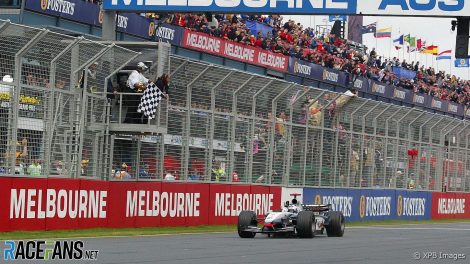



Aleš Norský
1st June 2021, 13:22
No memories of MP4/18?
GeeMac (@geemac)
1st June 2021, 13:28
It probably didn’t run long enough for him to develop any memories…
BasCB (@bascb)
1st June 2021, 15:09
Thanks for getting together (or on the phone/videocall etc) with David Coulthard to have a talk Dieter! I always really liked David, but always felt we never got to see all of him, so it is nice to get a bit more of his view of life over the years!
cduk_mugello (@cduk_mugello)
1st June 2021, 15:15
These articles are always great to read, probably the best thing on the site. I think a nice question to ask all of these interviewees would be “if you could keep just one of these cars, which one would it be?” cc @dieterrencken
sato113 (@sato113)
2nd June 2021, 12:23
+1!!! yes that would be a nice end question for these kind of interviews.
bookgrub (@bookgrub)
11th June 2021, 6:33
Agree. That would be very interesting, along with the reasoning of course.
Jonathan Parkin
1st June 2021, 15:46
Interesting Coulthard talks about how many engines he went through in one season racing with McLaren. At a time when I’m sure the team budgets weren’t anything like as high as they are now.
Cristian Ingles (@doctorlovesexy)
1st June 2021, 17:01
I’m pretty sure that is cheaper and easier to build 23 engines that last just one weekend than 3 engines that last 23 weekends.
Nathaniel
3rd June 2021, 16:46
The engines didn’t last a whole weekend. They had at least 3 in use as well as several spares. The practice engine, the qually engine which revved higher but didn’t last as long and then the race engine. So 3 engines minimum minus failures across roughly 17/18 races equals roughly 54 for a season. Easy to see how they used 100 really.
anon
1st June 2021, 20:33
Firstly, you have to bear in mind that McLaren wasn’t paying for the development of those engines directly, as Mercedes would have been bearing the brunt of those costs.
Secondly, the budgets of F1 teams were increasing extremely rapidly in the 1990s – although it is a couple of years later, McLaren’s budget was estimated to be $125 million in 1999, which would put it over $200 million today. Mercedes’s spending is a little harder to track, but the indication from Ilmor’s accounts from that period would suggest it was in the order of $100 million today – not exactly an inconsiderable sum.
@doctorlovesexy from what Illien has indicated in the past, it probably isn’t – he’s suggested that the cost of building a larger number of shorter lived engines is about the same as smaller number of engines with a longer operating life.
kpcart
2nd June 2021, 5:00
I would have loved to hear from Williams CVT from onboard and trackside camera
anon
2nd June 2021, 10:16
There is footage of the car being tested, though I am not really sure why you would be so excited to hear it. As noted in the article, all you hear is a constant engine pitch – if anything, it gets annoying after a while as it just forms a constant droning noise.
Sacha Gortchakoff (@gosac)
3rd June 2021, 7:59
while with shorter life-time engines, higher dev.rates possible ;
while more failures (i.a. fire & explosions ) serve for more on track action ;
making the claimed PUSHING of limits VISIBLE …
Sacha Gortchakoff (@gosac)
3rd June 2021, 7:59
IF motorsports are meant to feature sport among motors …
Balue (@balue)
1st June 2021, 17:07
Very good article. I liked Coulthard, but surprised he got the good drives when it was early apparent he was lacking.
Kringle
1st June 2021, 19:31
It seems like it’s just been lifted from the Beyond the Grid podcast.
John Bacho
3rd June 2021, 4:49
I flipped through the 20 March 2019 interview of Beyond the Grid w/ DC and I did not find this to be the case. There’s a little bit of overlap, similar topics of course, but the quotes and scope are different. The closest it gets is a discussion regarding McLaren’s 1998 Australian Grand Prix team orders; it’s a similar conversation, yes, but the quotes are not lifted from what I heard.
Though I didn’t listen to the entire 1 hour 23 min podcast, it’d be useful if you gave evidence (and timestamps) to make such claims. It was worth looking into, as I’ve found this publication (and other motorsport sites), are poor at referencing their material.
Jockey Ewing
1st June 2021, 19:44
A lot of great stories, very nice!
Carl Parker (@mysticarl)
2nd June 2021, 9:41
Nice – I remember the podium at Monaco with him in a cape, possibly the only time a grand prix podium finisher is dressed as a superhero?
Didn’t realise he won at Macau either.